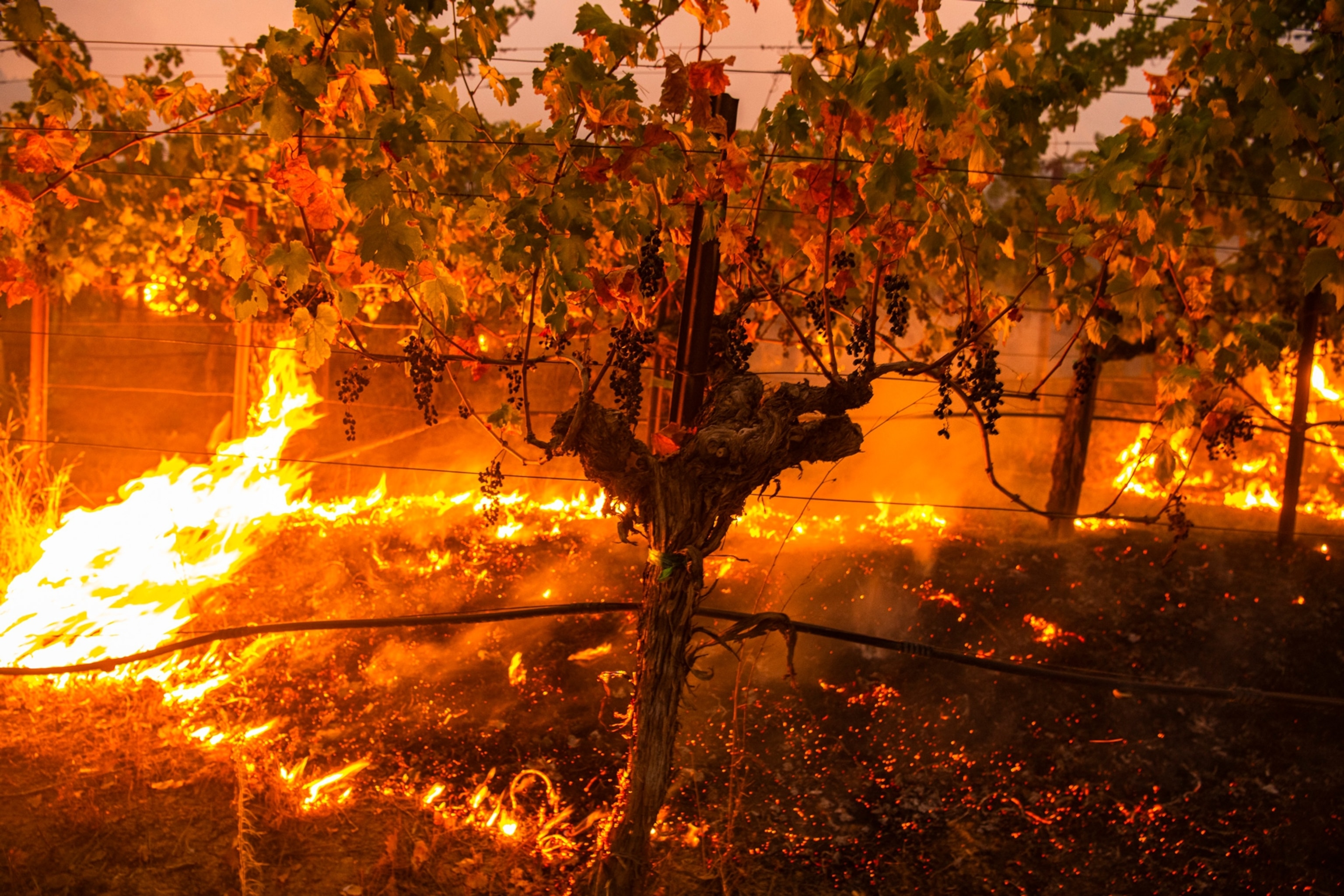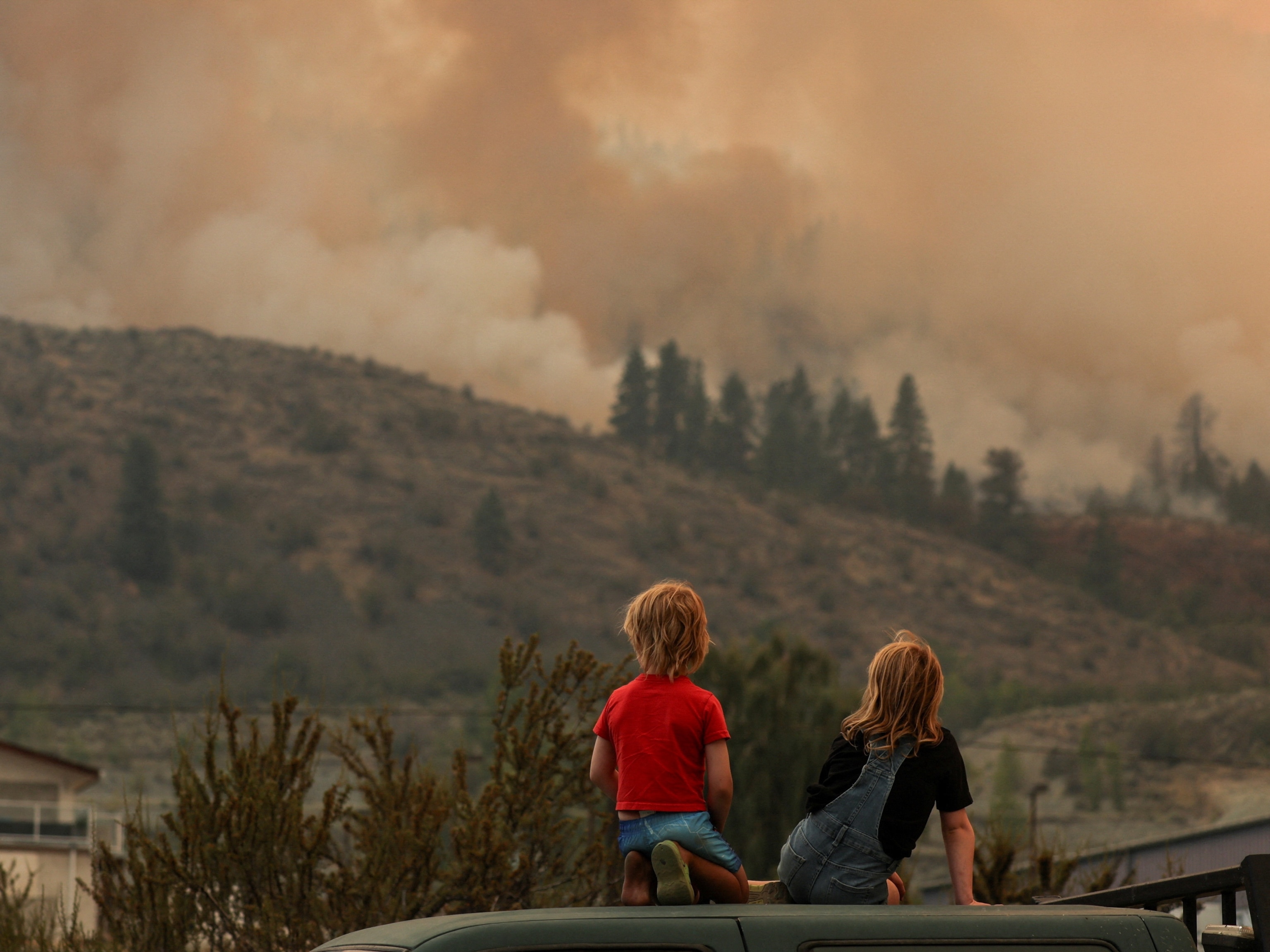
How the West’s wineries are battling ruinous wildfire smoke
As smoke blankets vineyards, it can coat grapes with particles that make wines taste like an ashtray, but scientists are innovating new ways to fight the dreaded “smoke taint.”
As dawn breaks at the Sokol Blosser Winery in Dayton, Oregon, Alex Sokol Blosser is already preparing for that day’s harvest of pinot noir wine grapes.
The winery, just southwest of Portland, is in the Willamette Valley, a region famous for producing the black-skinned grapes that make the rich, red wine sold there. But right now the climate in the valley feels unlike Oregon’s typically mild summers, Sokol Blosser says.
“It’s so dry. There’s dust everywhere. It’s just dry, dry, dry,” he says. “It’s been very, very warm.”
The grapes, growing on vines with deep roots, can handle that, he says. It’s the smoke rolling off the wildfires fueled by those dry, warm conditions that he worries about. Last year a record-breaking fire season scorched four million acres in the West and left many winemakers with a product deemed undrinkable.
“What happened in 2020 was a real catalyst for research around grape smoke exposure,” says Elizabeth Tomasino, a wine chemist at Oregon State University.
Working with wine scientists in California and Washington state, Tomasino is urgently researching how to help West Coast wine growers adapt their grapes to wildfire smoke. They’d like to find ways to prevent grapes from being contaminated in the first place, and to treat them when they have been.
A slight hint of smokiness in wine is a character that can be considered desirable. But when wine is smoke-tainted, Sokol Blosser says, it can be unbearable.
“Imagine drinking some lemonade and pouring someone’s ashtray into it,” he says.
While Sokol Blosser was able to salvage his harvest, many West Coast winemakers couldn’t; the 2020 vintage became a blank spot in many winery record books. Last year, fires cost the wine industry in the United States $3.7 billion, according to one estimate.
It’s a problem many wineries are likely to keep facing in coming years as heat and drought create more fuel for fires. Last year was California's largest wildfire season in its history. Nearly two million acres have burned so far this year.
“Drought and wildfires are the more apparent ways we’re seeing climate change,” says Anita Oberholster, a wine scientist at University of California, Davis.
Of the biggest environmental threats to California’s wine industry, “Fire is currently number one, just because last year almost every region had some risk of exposure and the smoke was widespread,” Oberholster says. “It went everywhere.”
Helping wine growers make the right decisions
In the northwest, Tom Collins has been busy installing smoke detectors throughout Yakima Valley, the heart of Washington State’s wine country.
An expert in wine and grape chemistry at Washington State University, Collins says 14 stations will be installed this year with more to come to create a large smoke detector network. Integrating the network’s data with weather forecasts could create warnings, telling wine growers —before they can smell it—that smoke might be headed their way and they might want to pick grapes early. Such a data system could also help them understand how much their vines have been exposed.
“Even a small fire near a vineyard can be problematic,” says Collins.
Scientists don’t yet fully understand what makes one vineyard exposed to smoke more likely to incur grape damage than the vineyard next door. Collins’ will combine data from the sensors with variables like elevation and distance from smoke to help growers understand if smoke exposure put their grapes at risk of being tainted.
That information could help grape growers know whether to spend the time and money getting their grapes tested for possible contamination, something they often must do to meet contract requirements or file for insurance. With increasingly widespread wildfires producing more smoke, more wineries are anxiously wondering if their wines are being impacted.
In California, smoke was so widespread last year, it created a logjam at university wine-testing sites.
“Our labs were overrun,” says Oberholster. “People were waiting months to get wine tested. They had to make harvesting and processing decisions without having any numbers.”
She said it may have caused unnecessary financial loss for some winemakers who assumed the smoke they saw over their fields had a definite impact on their grapes.
“I think there are loads of grapes that don't get harvested that could be harvested and make great wines. When you don’t have real data, people make decisions based on perception,” Oberholster says.
Taking a closer look inside grapes
When you smell something like the smoke from a recently doused campfire, you’re smelling particles called volatile phenols that float freely through the air. When those particles land on grape skins, they’re absorbed into the grape as sugars in the skins bind to the smoke compounds, meaning they can’t be simply washed off and won’t give off an aroma. Red wines, fermented for the longest period with their skins still on, are typically a bigger smoke taint concern than white wines. Because it’s been absorbed, sniffing or tasting the grape on the vine won’t easily reveal whether the grape has been tainted.
“It’s really during fermentation that those bound compounds are released,” Tomasino says. Based on the winemaker and technique, that could mean devoting nine months to a year of time and effort to make a wine—only to discover it has an aftertaste reminiscent of a cigarette, she says.
To help winemakers determine if their grapes are tainted, researchers are building a database of the average levels of certain chemicals found in wine.
At her university’s wine research lab, Oberholster has been fermenting wine from four different California vineyards, to measure what compounds in wine look like before being impacted by wildfire smoke.
“Our biggest problem at the moment in the U.S. is we don’t know what’s normal for a specific variety,” she says. There’s no baseline against which to measure the possible smoke effects.
For grapes that do get tested, the test results alone may not indicate whether a wine will taste like a wildfire. That’s because most grapes already naturally produce the compounds they test for—some varietals more than others—and there isn’t an official threshold that can definitely tell growers when their wine is tainted.
“You have a gray zone where it might be a problem, it might not be a problem,” says Tomasino. “We’d like to try and narrow that gray zone.”
In Oregon, Tomasino says she and her team are looking at a variety of potential solutions. Possibilities include coating grapes in a film that could block out smoke particles, or employing enzymes that would bind to smoke particles during the winemaking process and potentially remove the taste of smoke.
“A lot of new information is going to come out two to five years from now,” she says. “All those questions the industry has, those answers are achievable.”
A life preserver for the interim
From his vineyards, Sokol Blosser can see haze in the distance. It’s from wildfires burning in the Cascade Mountains that led to poor air quality in Willamette Valley a few days ago. And that was just one of more than 100 fires this year, including the Dixie Fire, California’s largest in recorded history.
If enough of that haze had reached Sokol Blosser’s winery with fresh smoke, it could have imbued this year’s vintage with the acrid taste of wildfire.
To salvage what they could after last year’s devastating fires, some winemakers got creative. They turned their wine into brandy, or offered smoke-tainted wine for patrons to try at special winery tastings.
For Sokol Blosser, it was the first time he had dealt with smoke taint in the Willamette Valley and about 15 percent of his wine was smoky.
Acknowledging the changing climate and the likelihood for dangerous fire seasons to continue, he saw it as an opportunity to adapt.
“If we can’t figure out how to make wine with wildfires burning, then maybe we should become distillers,” he jokes.
But this isn’t just a business. It’s a legacy from his parents, a family operation planted by Susan Sokol and Bill Blosser 50 years ago before Oregon even had a wine industry.
“Our calculus was this: This won’t be the last time this happens,” the son says. And adapting was the only option.
Sokol Blosser placed a call to Jeff Murrell, a Napa-based chemist working in the wine industry, who had recently developed a new method to remove the taste of wildfire smoke from wine.
“I was tasting something more akin to an unpleasant tannin—they give you that grippy, drying aspect of wine,” Murrell says of first tasting smoke-tainted wine. To remove that dry aspect, altering what vintners called “mouthfeel,” he developed a resin that stripped the wine of the phenols associated with smoke.
As wine passes from one tank to another, it passes through Murrell’s steel tanks, the relative size and shape of a party store’s helium tank, where screens containing the resin trap smoke particles but allow the wine to pass through. Murrell can pump through 100 gallons per minute, filtering out the taste of smoke. He’s hopeful that wineries won’t need a device like this as much this year as they did last year. But he thinks his new technology could be a useful “life preserver” for wineries increasingly battling wildfire smoke.
“I think everyone’s concerned about climate change and the dramatic change in our wildfire occurrence in the past five years,” says Murrell. “I’ve lived in Napa for over 20 years and we didn’t even really talk or think about it [before]. It wasn’t really a thing.”
Last year, he estimates, more than five million bottles of wine from 200 wineries along the West Coast had smoke taint removed by his invention.
Oberholster says treatments like Murrell’s can help tainted wine in some cases, but they tend to indiscriminately remove certain aspects of wine that makers want to keep. That won’t necessarily be sustainable long term for an industry that prides itself on its product’s complexity.
While she and other scientists continue to work on industry solutions, Oberholster encourages fans of West Coast wines to keep visiting their favorite wineries. “The wine industry is going through a difficult time,” she says. “They need support from their consumers. If people see a vintage 2020 or vintage 2021, they should trust that wine is the quality they would expect.”








